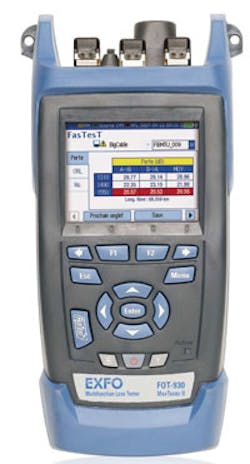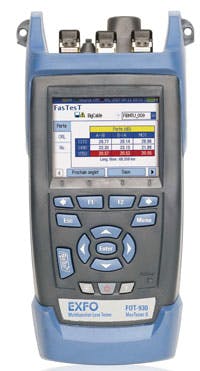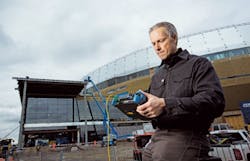From the January, 2015 Issue of Cabling Installation & Maintenance Magazine
Even when the cabling components differ from those traditionally used for LANs, testing an installed system is key to the network's ultimate performance.
By Patrick McLaughlin
Over the past half-dozen or so years, enterprise distributed antenna system (DAS) networks have gone from being luxuries for tenants and guests of venues, and competitive advantages for the facilities that have them, to being expected amenities by those tenants and guests, and must-haves for facilities intending to remain competitive. This evolution is particularly true in the entertainment and hospitality industries, where visitors to hotels, arenas, and convention halls no longer anticipate having to walk to a window or even outside to obtain an adequate signal for their mobile devices. A lack of connectivity may be more accepted inside a corporate office building, but begrudgingly so.
In many cases an organization's ability to provide such connectivity requires an on-premises DAS, and in many of those cases, the building owner--not the wireless carrier(s)--is responsible for the DAS's design, construction, maintenance, and associated costs. As we have written in previous articles, the business dealings between building owners and wireless carriers during a DAS-installation project are complicated. The frequencies through which 3G/4G/LTE wireless signals travel are regulated and licensed, and wireless carriers paid hefty sums via Federal Communications Commission auction to obtain and use those frequencies. These carriers do not frivolously grant spectrum access to any building owner desiring it. Rather, they require applicants to provide not just a business case, but also a set of technical specifications that provides assurance the on-premises DAS will capably support the transmission of their signals. With monthly subscription rates for wireless plans being what they are, carriers cannot afford to risk losing subscribers who experience insufficient coverage or capacity that, unbeknownst to those subscribers, is a result of an inadequately designed, installed or administered on-premises DAS.
For this reason especially, expertise in radio-frequency (RF) design is an essential capability in successful DAS deployment. In addition to a proper design, prospective on-premises DAS owners must demonstrate to carriers whose signals they intend to retransmit and propagate, that the active and passive components of the DAS also are up to the task. Once one or more carriers approve the plan, the proverbial table is set for a DAS installation; the design and components have been established. That, of course, is where the cabling installers come in. And for the purposes of this article in particular, it also is where test technicians come in.
Testing procedures for the cabling infrastructure that supports an on-premises DAS have both similarities to and differences from testing procedures for the cabling infrastructure supporting a wired voice or data network. There is no "autotest" button to initiate a comprehensive test suite and ensure the installed cabling system exhibits the performance characteristics needed to support the DAS's signal transmission. There are however some familiar tools, measurements, and processes involved when the DAS architecture employed is what is commonly referred to as "hybrid."
DAS types and cabling
A hybrid DAS is so-named because it is a hybrid of passive and active DAS architectures. In a white paper titled "What's at the Antenna Counts," TE Connectivity (www.te.com) describes the differences among the three types. TE offers active DAS and the paper details the features and benefits of that type. In it, TE says, "In a purely passive DAS, a main distribution unit, co-located with a base station, drives the wireless base station signals over the coaxial cable network to antennas placed at the ends of the cables. The signals experience significant attenuation as they propagate through the coaxial cable network …
"Hybrid DAS typically use fiber-optic cabling to carry the signal from a main distribution unit, that is co-located with the base station, up a building riser to a remote unit, which contains the amplifiers used to drive the thick coaxial cabling horizontally across each floor of the building," TE's paper continues. It describes active DAS as follows: "The most prominent differentiators of active DAS are distributed amplifiers at the antenna points … TE Connectivity's active DAS products employ the same network architecture as Ethernet LAN and use the same standard building cabling … In TE Connectivity's implementation of active DAS, a main distribution unit is co-located with the RF source, such as a base station or repeater, in a building's equipment room or nearby cell site. The main distribution unit is analogous to a network server in a LAN network that is located in a building computer network room. The main distribution unit distributes signals from the RF source over optical fiber to intermediate distribution units typically referred to as expansion units that are often located in telecom closets on different floors of a building … The expansion units in a TE active DAS then distribute the wireless signals using standard building cabling to the remote access unit (RAU) located at the specific antenna points in a building."
The cabling infrastructure supporting the active DAS described by TE Connectivity has the familiar fiber-optic backbone widely seen throughout enterprise networks. Commonly the horizontal portion of the DAS cabling infrastructure comprises coaxial cabling, often 50-ohm and sometimes 75-ohm. As such, this article will discuss some practicalities of testing a hybrid DAS's cabling infrastructure including coaxial cable.
Tools and techniques
Richard Baldasarre, senior mobility solutions architect with Vision Technologies (www.visiontech.biz), is a veteran of RF design, DAS deployments and related technologies. He points out that although some of the specific fiber-optic cabling components of a DAS-supporting backbone may differ from those used in LAN support, the tools and procedures for testing these fiber-optic systems are similar. "To test the fiber-optic system, a power meter, with light source, and an OTDR both can measure reflections and cable loss," he explains.
In EXFO's (www.exfo.com) Distributed Antenna System Testing Guide, the company goes into significant detail about the tools and procedures needed to inspect and test a DAS's fiber-optic infrastructure. In the guide the company explains, "A testing method based on reflectometry will provide the IL/ORL [insertion loss/optical return loss] characterization desired during the construction phase, and will also allow for detection and positioning of the following issues, if present on the link: fiber misalignment, fiber mismatch, high-loss or reflective connectors, high-loss splitter branches, fiber breaks, macrobends.
"Bidirectional testing is specifically recommended when there are splices present on the fiber," EXFO continues. "When splicing different types of fiber and testing with a reflectometry-based method, a significant loss or gain (depending on the test direction) could appear due to the difference in the fiber's mode-field diameters. A good example of this would be splicing G.652D [standard singlemode] fiber with G.657 [bend-insensitive singlemode] fiber. In such a case, the only way to get the real loss value of the splice is to test from both directions, and to average the loss values of both directions."
So depending upon the fiber types used for DAS infrastructure, more- or less-complicated testing procedures will be needed. EXFO's guide also addresses the use of an optical-loss test set (OLTS)--the combination of light source and power meter--to conduct DAS fiber-optic cabling tests. The company explains an OLTS "is used to determine the total amount of loss or attenuation in a fiber span under test. As with a standard OPM [optical power meter] and OLS [optical light source], referencing needs to be performed prior to the test. To perform the measurement, one of the technicians must connect the fiber under test to his or her OLS port, and the other technicians must connect the same fiber to his or her OPM port.
"One advantage of measuring loss using an OLTS is that you can obtain bidirectional test results without having to change the location of the instrument … Automated OLTS are available on the market. The main particularity of those OLTS is that they combine the OPM and the OLS in the same port. This enables the test instrument to perform the bidirectional test without the need for the test port to be changed."
Vision Technologies' Baldasarre emphasizes that the results of these tests--i.e. the actual insertion loss and return loss performance of the installed fiber cabling--matter greatly, particularly in hybrid DAS setups. In those networks, he explains, what's really happening over the fiber is "the transporting of analog-based RF signals that have been converted. Because of that fact, reflections are very important" to the successful transmission of the signal, he adds. With reflections being a significant factor in these RF transmissions, the fiber-optic systems most often use APC, angle-polished connectors. That is unlike the backbone fiber cabling systems used to support LAN environments, which typically use flat-polished connectors. APC connectors cut down on reflections, thereby reducing signal degradation.
Coaxial characteristics
The other cabling subsystem in a hybrid DAS is coaxial. "Most use 50-ohm coaxial," Baldasarre notes. The setup, he explains, includes, "an RF amplifier in the telecom room, and from that RF amplifier, coaxial cabling carries the RF signal to passive antennas."
As previously quoted, TE Connectivity's paper describing passive, active and hybrid DAS architectures, while extolling the benefits of active, refers to "thick coaxial cabling" within hybrid DAS. The cable's thickness has a purpose, as Baldasarre explains: "The thicker the cable is, the less loss it will have, and the better coverage the DAS will provide."
Another characteristic of the 50-ohm coaxial cable typically used is that it has an air core or air dielectric. That air dielectric can make the cable susceptible to kinds, bends and crushing. "The cable's outer conductor provides a waveguide for the RF," Baldasarre says, "and kinks or crush can affect the RF signal."
As is also the case with the fiber portion of the cabling, the performance of the installed coaxial cabling is paramount to the ability of the DAS's antennas to provide adequate coverage. And once again, return loss is a key performance characteristic. The test tool of choice here often is the cable sweep tester, which performance frequency domain reflectometry. Higher-end tools can act as both a cable tester and a spectrum analyzer. Baldasarre explains that when a spectrum analyzer is used, it "reads the RF signal and measures the return loss." The measurement also can provide an indication of the integrity and performance of connectors in the coaxial link, he adds. A high-dB loss will display as a blip of sorts on the spectrum analyzer's display.
Perils of PIM
As for the causes of connection-performance anomalies, a common culprit is passive intermodulation (PIM). Baldasarre points out that while a spectrum analyzer may indicate the existence of a performance anomaly at a connection, the cable tester "won't necessarily give you information about contamination or metal shavings in the cable if a termination is done incorrectly. That's where a PIM tester comes in."
PIM testers are available from multiple manufacturers, and several of those manufacturers provide fundamental information about PIM. Anritsu (www.anritsu.com) and Kaelus (www.kaelus.com) are among the PIM-tester manufacturers to offer such information. In a frequently-asked-questions portion of its website, Kaelus explains that PIM "occurs in passive devices [and] is present whenever RF signals at two or more frequencies are simultaneously present in a conductor of RF energy. Every passive RF device generates PIM products when more than one frequency is present in the device. The signals are mixed by the non-linear properties of junctions between dissimilar materials."
Typical causes of PIM, Kaelus further explains, include "In RF components (antennas, cables, filters, etc.) there are typically three causes: 1) Poor mechanical junction in the RF path; 2) RF components fabricated with materials which exhibit some level of hysteresis (e.g. stainless steel); 3) Contaminated surfaces or contacts within the RF path. Examples might include flux and metallic particles from the machining process."
An important caveat about PIM: The condition is most prevalent in high-power distributed antenna systems. Many in-building DAS are low-power, therefore not necessarily subject to PIM, at least not to the severity described by Kaelus and Anritsu. Even so, an on-premises DAS that extends across a campus, runs outside, or otherwise covers a large area may be high- rather than low-power, and subject to the perils of PIM.
In a document titled "Understanding PIM" and available on its website, Anritsu provides several pages of detail on PIM, its causes, characteristics, and intricacies of testing for it. In the document the company explains, "PIM is a form of intermodulation distortion that occurs in components normally thought of as linear, such as cables, connectors and antennas. However, when subject to the high RF powers found in cellular systems, these devices can generate intermodulation signals at -80 dBm or higher.
"PIM comes from two or more strong signals and a nonlinear junction," Anritsu further explains. "The strong signals normally come from transmitters sharing an antenna run, transmitters using adjacent antennas or nearby towers with conflicting antenna patterns. Damaged or poorly torqued RF connections, contamination, fatigue breaks, cold solder joints, and corrosion can create nonlinear junctions … Damaged connectors, cables, duplexers, circulators, and antennas all can contain nonlinear components."
Elsewhere in its document, Anritsu says, "Connectors on the antenna run are the first suspects in any PIM hunt. Connectors are a likely cause of PIM and subject to a number of problems. First, if the mating surfaces have small gaps, a ‘potential voltage barrier' can be formed that allows electron tunneling or microscopic arcing to take place. Either will cause PIM in the presence of strong signals. Damaged caused by overtightening, insufficient contact pressure, distorted contact surfaces, foreign materials in the mating surfaces, or corrosion can cause small gaps … Cutting the cable at installation time may create metal particles or debris. If some of these particles remain in the cable, or get into the finished connector, they can cause PIM when they touch a current-carrying surface. Contaminates can be a source of intermittent PIM if the cable assembly is flexing with temperature or from the wind."
The document also addresses the cable: "Cables do not typically cause PIM, but poorly terminated or damaged cables can and do cause problems. Beware of cables with a seam in the shielding. As the cable ages, its seam can corrode, causing PIM. The cable's center conductor may also be faulty because plated copper does not always adhere well to the aluminum core. The copper can flake off if poorly manufactured, creating metal particles and poor connections that have the potential to create intermittent PIM."
The installation and verification, through testing, of the cabling systems that support on-premises DAS are critical to the DAS's ability to provide coverage and capacity to users.
Patrick McLaughlin is our chief editor.
Archived CIM Issues
About the Author
Patrick McLaughlin
Chief Editor
Patrick McLaughlin, chief editor of Cabling Installation & Maintenance, has covered the cabling industry for more than 20 years. He has authored hundreds of articles on technical and business topics related to the specification, design, installation, and management of information communications technology systems. McLaughlin has presented at live in-person and online events, and he has spearheaded cablinginstall.com's webcast seminar programs for 15 years.



